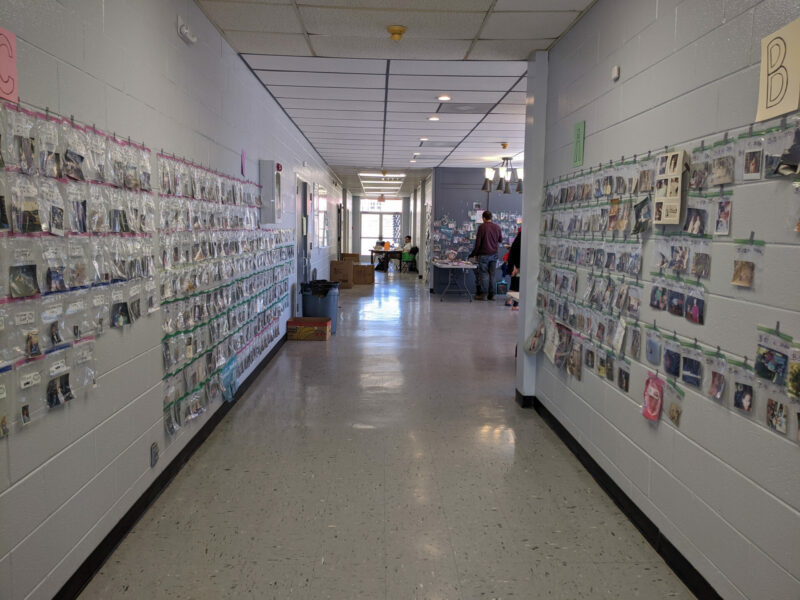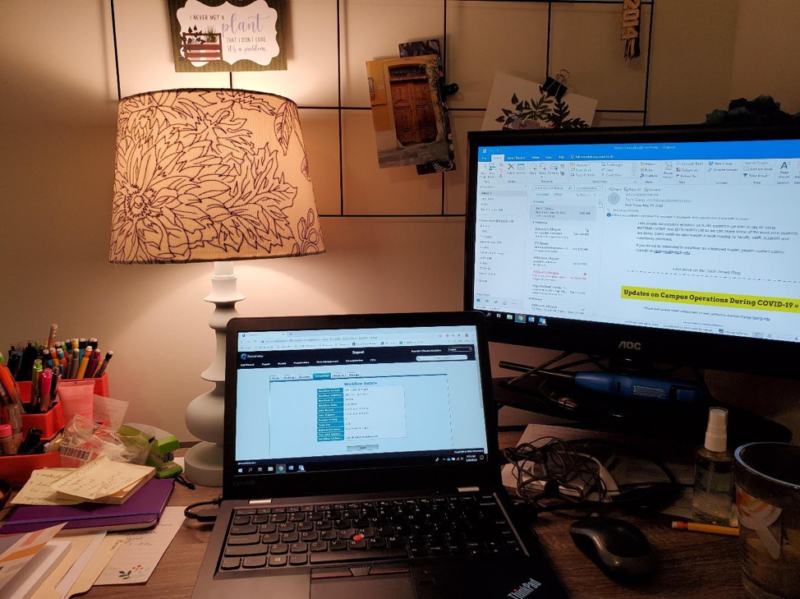Navigating overlapping traumas as a new professional
01 October 2020 – Hannah O’Daniel McCallon
covid-19, 2020 Archives Month Series, community history, digital collecting, archives, disaster planning, rapid response, community engagement, racial violence, pandemic
Editors’ Note: This is one in a series of posts about the intersection of archives and public history in the age of COVID-19 that will be published throughout October, Archives Month in the United States. This series is edited by National Council on Public History (NCPH) board member Krista McCracken, History@Work affiliate editor Kristin O’Brassill-Kulfan, and NCPH The Public Historian co-editor/Digital Media Editor Nicole Belolan.
Living and working in a new place is disorienting. Public history work is often grounded in knowing the needs, culture, and history of the communities the practitioner seeks to engage with. How does a new professional tackle building community connections and familiarity to function in a way that is supportive, respectful, and ethical, all while overlapping crises and traumatic events are occurring? This essay explores my attempts to learn about and connect with the Upper Cumberland region of Tennessee after moving, assisting survivors of a tornado, and witnessing Black Lives Matter protests during the COVID-19 pandemic.
I spent my first month as the new assistant archivist in the Tennessee Technological University Archives and Special Collections simply acclimating. My initial efforts for community connection building consisted of observations from a distance. I read the local newspaper, browsed posts in regional and county Facebook groups, and read academic and local history works on the region. At work, I processed the personal papers of a former president of the university. All of these activities helped me learn about the area, but the sources represented a predominantly white, evangelical Christian view of the region, while excluding the small but diverse non-white population.
Nearly 350,000 people live in the 14 counties that make up the rural Upper Cumberland region. Of these residents, about 4.4% are Hispanic or Latinx, 1.7% are of multiple races, 1.4% are African American or Black, 0.6% are Asian, and 0.3% are Indigenous. About 90,000 of the residents are immigrants. A 2010 religious census indicated that almost 155,000 residents of the Upper Cumberland adhered to an organized religion, of which about 78% identify as Evangelical Protestant. Smaller groups of adherents include Black Protestant, mainline Protestant, Catholic, Bahá’í, Vajrayana Buddhist, Hindu, Mennonite, Muslim, and Reform Judaism. The white and evangelical population is undeniably large, and there is more diversity in the area than than documented in the sources I first consulted.
Tragedy and trauma further complicated my efforts to learn and connect. Early in the morning on March 3, 2020, multiple tornadoes hit Middle Tennessee. The storm killed nineteen people and displaced hundreds of households in my new home of Putnam County. Locals and outsiders jumped in to help, so much so that emergency workers and donation sites quickly became overwhelmed by volunteers and donations. I witnessed residents creating multiple Facebook groups to post belongings scattered by the storm and multiple institutions volunteering themselves as drop-off locations for displaced items. Through social media and word of mouth, we learned that survivors were overwhelmed by repeatedly needing to check at multiple locations for their belongings.

A long hallway in the Cookeville Community Center, with bagged photographs and other documents tapped to walls for people to claim. Photo credit: Megan Atkinson
My colleagues and I agreed that we could pause our normal work and offer our preservation and organization skills and long-term, climate-controlled storage to the volunteer team that formed at the Cookeville Community Center, one of the main sites where people dropped off belongings. Careful to follow the lead of the original organizers, we took shifts helping to clean and organize photographs and documents at the center, with the end goal of returning the materials to their owners. The Archives photographed the belongings, uploaded the photographs to a private Flickr album, and shared the album with survivors and their families so they could browse and claim their materials at their convenience. We gradually transferred batches of the materials to the Archives, where students and other volunteers helped with the cleaning and digitization work.
Meanwhile, the COVID-19 pandemic loomed over our heads. The virus had not reached the region when the tornadoes hit, but within two weeks the Archives staff had two COVID-19 exposure scares, one of which was tied to volunteering at the Cookeville Community Center. By the end of March, local officials closed the Community Center to slow the spread of the virus. My supervisor transferred the remaining thousands of unclaimed photographs to the Archives and they managed socially distanced deliveries of the materials to families.
My work with the tornado recovery lasted two weeks before human resources approved my request to work from home. I was relieved to have the privilege of a steady paycheck and the ability to work remotely, but yet another change in my work environment was difficult to adjust to after the upheaval of the tornado and recent move. The isolation of working from home also complicated my efforts to make meaningful connections with local people. The virus morphed the community I wanted to learn about and engage with into a threat to my and my loved ones’ wellbeing.
Working remotely meant my duties shifted from mostly working with paper-based collections to adding more materials to the Archives’s digital collections. Immediately collecting personal stories on the recent tornado and unfolding pandemic would have been opportunistic and likely harmful. Instead, I worked on crawling public and Tennessee Tech websites related to both topics and collecting other digitally published ephemeral materials. In combing the Internet and social media platforms for glimpses of how the residents of the region responded to the pandemic, I learned far more about the area than I would have by processing individual paper-based collections in the office. But much like the perspectives given through published scholarship and local newspapers, white and evangelical perspectives dominated what could be gleaned from the web. Spending my workdays focused on pandemic-related material also made me hyper-aware of the lack of concern for public health and safety exhibited in many spaces. Reading social media comments spreading conspiracy theories and ableism further made me question my safety and wore on my anxiety.

Makeshift work from home space in the corner of my apartment bedroom. The laptop screen shows a stage in the web crawling process in Preservica, the Archives’ digital preservation software. Photo credit: Hannah O’Daniel McCallon
At the same time, young people organized Black Lives Matter protests in Upper Cumberland small towns in late May and early June in response to the police murder of George Floyd, Breonna Taylor, and countless others. White supremacists retaliated by amplifying their voices in the region. Some of the digital spaces I monitored for glimpses of life during the pandemic became sites of racist dog whistles and fear-mongering over fictitious outsiders infiltrating the small towns to destroy private property. White people leveraged the recent tragedy of the tornado and disruption of the pandemic as an excuse to denounce and harass the protestors as troublemakers disturbing the needed peace, all while ignoring the lack of peace for their Black neighbors. Despite all the violent online noise and physical attacks on protestors, the Upper Cumberland’s antiracist and Black organizations made themselves highly visible through media interviews, social media activity, and the protests, countering the overwhelmingly white view of the region.
After the Black Lives Matter protests, I connected with some of the participants and learned more about the groups that regularly hold direct actions in Cookeville. I volunteered with the drive-thru Juneteenth celebration in Cookeville and met more diverse community organizers. Administrators of Tennessee Tech’s Office of Multicultural Affairs and Black Cultural Center invited the Archives to assist with digital exhibits and programming for the Black Cultural Center’s 30th anniversary, which is leading to more connections in the university community and beyond.
After eight months of living in Tennessee, I neither know as much about the community as I would like to nor do I feel that my efforts to connect have been noteworthy or enough. I am still struggling with finding ways to engage in this work from a distance and protect my mental health in the process. My suggestions for those in similar circumstances is to be patient and lower expectations, especially during this pandemic. Our communities—and ourselves—are focused on surviving right now, and that is more than enough.
~Hannah O’Daniel McCallon is the assistant archivist at Tennessee Technological University Archives and Special Collections.



